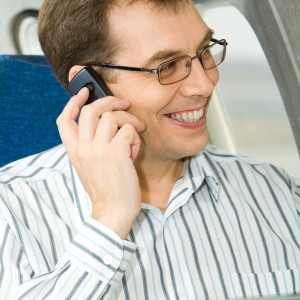The U.S. Department of Transportation (DoT) has begun a rulemaking process that would ban in-flight cellular services on commercial flights. This rulemaking is in reaction to the proposed rule changes from the Federal Communications Commission (FCC) to enable new technology, which has already proven safe for use on board aircraft. The effect of the proposed rule changes runs counter to the notion that a new technology would expose passengers to hours of indolent chatter from dozens of people on the same flight.
It might surprise many that this technology is not new. In fact, a lot of us have been on cellphone-enabled planes and not known it.
Many international airlines worldwide already permit cellular service, including voice calls. More than 20 cellphone-enabled flights a day travel between the U.S. and other countries, which should lead the Department of Transportation (DoT) to look at the experience these airlines have had with cell service.
And they have.
In 2012, the Federal Aviation Administration (FAA) – an agency within the DoT– surveyed twelve international civil aviation authorities. They learned that non-U.S. airlines offer a wide variety of connected services utilizing the latest air-to-satellite and cellular technologies, including text messaging, Internet connections, voice calls or a combination of all three.
They also learned that there have been no – zero –reports of a flight disruption due to cellular phone activity. In fact, according to the FAA report, a few passengers complained when the cellphone service was interrupted during flight.
In the U.S., services already exist which allow airline passengers to check email or browse the Internet. A quick glance around the cabin on a U.S. flight of even relatively short duration will illustrate the utility of passengers having that capability. The option of utilizing cellular services further enhances the convenience of these services.
And U.S. passengers previously had the option to talk on phones while in flight, as well. As early as the 1980’s AirPhone systems were tested and installed on U.S. aircraft– phones were wired to each seat or each row. The service was discontinued because, according to one executive, most flights had fewer than three or four phone calls.
The world has adopted the idea of being connected all the time. People everywhere are checking their mail or their social connections via their mobile devices. It’s not surprising that people would choose to stay connected during long flights, as well.
Whether the DoT should allow cellular voice options on U.S. carriers is a choice for the American consumer. Already carriers such as Southwest and Delta have promised customers that they will not allow voice service.
Such is their preference. But other airlines and passengers may not choose voiceless flights. They may want to have access to a cellphone to listen in to a conference call or be available for a loved one who may need to reach them on a long-haul flight. The DoT can enable these choices to take place.
The U.S. DOT should follow the lead of the FCC and leave it to airlines and their passengers to decide what, if any, connected services they wish to offer on their aircraft. The issue of cellular services in flight is about choice, not voice.

